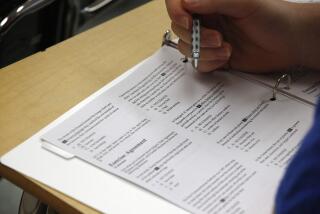Achievement gaps widen for California’s black and Latino students

Students at Francisco Bravo Medical Magnet High School in Los Angeles take a practice test earlier this year for new state standardized tests.
For more than a decade, state educators have focused on helping black and Latino students perform as well in school as their white and Asian peers, calling the issue a social and economic imperative.
Data from a more difficult, new state testing system suggest that they still have a long way to go.
The new wave of tests, given in California and elsewhere, provide a more accurate gauge of academic skills, according to experts who support the system. If they are right, then the problem facing black and Latino students, which already was considered serious, is of greater magnitude.
“This is going to show the real achievement gap,” said Chris Minnich, executive director of the Council of Chief State School Officers. “We are asking more out of our kids and I think that’s a good thing.”
At the same time, he added, “there’s no question that when we raised the bar for students that we’re going to have to support our lower-achieving students even more so than we are now.”
Although scores declined for all students, blacks and Latinos saw significantly greater drops than whites and Asians, widening the already large gap that was evident in results from earlier years, according to a Times analysis.
Under the previous test, last given to public school students two years ago, the gap separating Asian and black students was 35 percentage points in English. The gap increased to 44 percentage points under the new test. Asian students’ results dropped the least on the new tests, which widened the gap between them and those who are white, black or Latino, the analysis showed.
White students also maintained higher relative scores than their black and Latino peers.
A similar pattern occurred with students from low-income families. Their scores in math, for example, declined at a steeper rate (51%) than those of students from more affluent backgrounds (16%). In the last decade, all ethnic groups made significant academic gains compared to where their scores started. But the gap separating the scores of blacks and Latinos from whites and Asians changed little.
The new tests are based on state learning goals for each grade, called the Common Core; they have been adopted by 42 states. For the first time, the exams were given on computers. Questions become more difficult depending on students’ answers. Scoring is designed to be in line with what students would need to be successful in a four-year college, a higher standard than in the past.
The results of the new tests should sound an alarm, if one was needed, said Bill Lucia, of the Sacramento-based advocacy group EdVoice. “There’s a problem and it’s not, per se, the test,” Lucia said. “There is something going on here when you talk about the difference in the size of the gap, particularly in math.”
In that subject, 69% of Asian students achieved the state targets compared to 49% of whites, 21% of Latinos and 16% of blacks.
Although even Asian students have room to improve, their relative performance stood out. In math, the percentage of Asians who met state targets declined 12%. White students went down 21%, Latinos 50%, black students 54%. More than half the students who took the test were Latino.
The future of California, Lucia said, will depend on students of color graduating from schools with the skills they need to succeed in college and careers.
A top-performing school district was San Marino Unified, which is located in a mostly high-income area and enrolls 56% Asian students; 84% of students met state learning goals in both English and math.
L.A. Unified, which enrolls a majority of low-income, minority students, fared much worse overall. Achievement gaps widened less in L.A. Unified than in the state as a whole but that’s largely because its white and Asian students declined more, according to the analysis.
In L.A. Unified, 67% of Asian students met state targets in English, compared to 61% of white students, 27% of Latinos and 24% of black students.
Schools that did worse may have “relied on narrow forms of test preparation, so they spent less time on critical thinking activities” which are emphasized on the test, said Maria Brenes, executive director of InnerCity Struggle, a nonprofit that works with schools east of downtown, which have mostly Latino students.
To narrow the achievement gap, she said L.A. Unified should invest more in technology, teacher training and parent education about the new learning goals.
Administrators at Granada Hills Charter High School attribute their encouraging scores to campus-wide efforts to teach the new learning standards.
The school is 39% Latino, 28% Asian, 27% white and 5% African American. About half of the students are from lower-income families. And, 58% of students hit state targets in math; 76% in English.
Across the state, technology could have proved a factor in the scores because many students have limited experience with computers.
“Students in lower-wealth schools that did not have extensive technology access and who do not have technology at home had another challenge in taking these tests,” said Linda Darling-Hammond, the faculty director of the Stanford Center for Opportunity Policy in Education, who supports the learning goals. “Their scores are likely to be artificially lower on this first round of testing.”
Additionally, some districts had to devote available resources to buying computers, diverting funds from efforts to train teachers, said Deb Sigman, deputy director of assessment and standards for WestEd, a San Francisco-based research group that makes policy recommendations.
Sigman agreed with state officials who have warned against making comparisons between the old and new tests, which are different in form and content. They also are more rigorously graded. These factors combined to result in much lower overall scores; far fewer students achieved state learning targets.
When asked about the widening gap, a state representative declined to comment on The Times’ analysis. But state Supt. of Public Instruction Tom Torlakson acknowledged this week the persistence of a long-recognized problem.
“The results also show we continue to have an achievement gap,” Torlakson said. “We must work to reduce this gap.”
He said the state is moving in the right direction, particularly with new school funding that provides more money and services to students “with the greatest needs.”
L.A. Board of Education President Steve Zimmer said the results need to be carefully interpreted, and that a variety of factors could have affected the scores, particularly in the first year.
Zimmer cited Hoover Elementary as one that showed better progress than might be expected at a campus that is 98% Latino and 96% low-income; 85% are learning English.
Martha Avelar, Hoover principal, said teachers pushed students to explain their answers, not just give them — one of many key instructional strategies. Teachers also worked in grade-level teams and created their own sample tests.
“We don’t think of our students as low-income, minority students,” she said. “We think all of our kids will go to college, and preparation starts now.”
But even there, students have not caught up to state targets: 31% of students met them in math; 42% in English.
howard.blume@latimes.com
Times staff writer Teresa Watanabe contributed to this report. Ryan Menezes and Sandra Poindexter provided data analysis.
Twitter: @howardblume
MORE IN EDUCATION NEWS:
New California tests present sobering picture of student achievement
Top California schools lose less ground as statewide test scores tumble
What Californians can learn from other states’ Common Core test results
More to Read
Start your day right
Sign up for Essential California for news, features and recommendations from the L.A. Times and beyond in your inbox six days a week.
You may occasionally receive promotional content from the Los Angeles Times.







